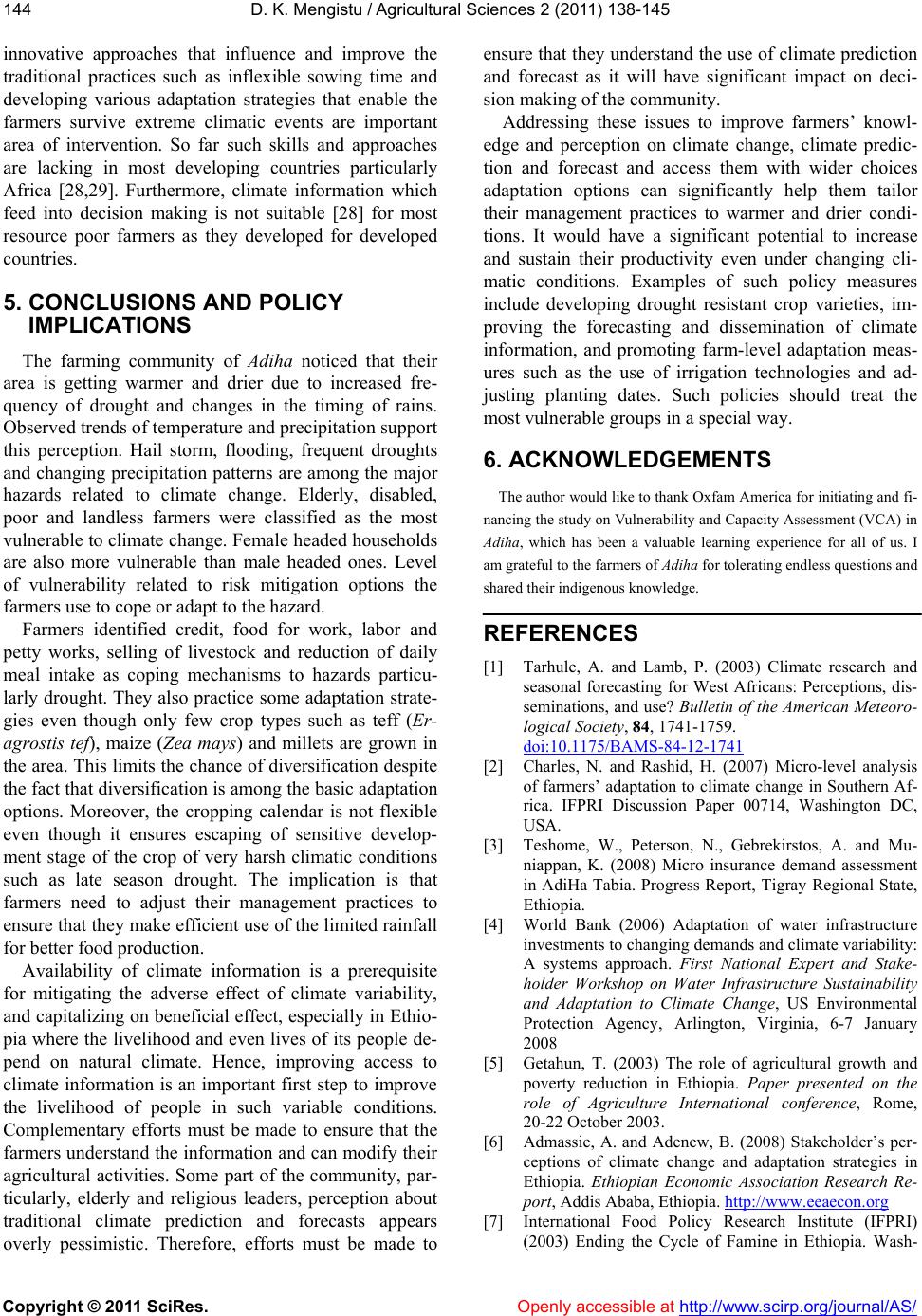
D. K. Mengistu / Agricultural Sciences 2 (2011) 138-14 5
Copyright © 2011 SciRes. Openly accessible at http://www.scirp.org/journal/AS/
144
innovative approaches that influence and improve the
traditional practices such as inflexible sowing time and
developing various adaptation strategies that enable the
farmers survive extreme climatic events are important
area of intervention. So far such skills and approaches
are lacking in most developing countries particularly
Africa [28,29]. Furthermore, climate information which
feed into decision making is not suitable [28] for most
resource poor farmers as they developed for developed
countries.
5. CONCLUSIONS AND POLICY
IMPLICATIONS
The farming community of Adiha noticed that their
area is getting warmer and drier due to increased fre-
quency of drought and changes in the timing of rains.
Observed trends of temperature and precipitation support
this perception. Hail storm, flooding, frequent droughts
and changing precipitation patterns are among the major
hazards related to climate change. Elderly, disabled,
poor and landless farmers were classified as the most
vulnerable to climate change. Female headed households
are also more vulnerable than male headed ones. Level
of vulnerability related to risk mitigation options the
farmers use to cope or adapt to the hazard.
Farmers identified credit, food for work, labor and
petty works, selling of livestock and reduction of daily
meal intake as coping mechanisms to hazards particu-
larly drought. They also practice some adaptation strate-
gies even though only few crop types such as teff (Er-
agrostis tef), maize (Zea mays) and millets are grown in
the area. This limits the chance of diversification despite
the fact that diversification is among the basic adaptation
options. Moreover, the cropping calendar is not flexible
even though it ensures escaping of sensitive develop-
ment stage of the crop of very harsh climatic conditions
such as late season drought. The implication is that
farmers need to adjust their management practices to
ensure that they make efficient use of the limited rainfall
for better fo o d p r oduction.
Availability of climate information is a prerequisite
for mitigating the adverse effect of climate variability,
and capitalizing on beneficial effect, especially in Ethio-
pia where the livelihood and even lives of its people de-
pend on natural climate. Hence, improving access to
climate information is an imp ortant first step to improve
the livelihood of people in such variable conditions.
Complementary efforts must be made to ensure that the
farmers understand the information and can modify their
agricultural activities. Some part of the community, par-
ticularly, elderly and religious leaders, perception about
traditional climate prediction and forecasts appears
overly pessimistic. Therefore, efforts must be made to
ensure that they understand the use of climate prediction
and forecast as it will have significant impact on deci-
sion making of the community.
Addressing these issues to improve farmers’ knowl-
edge and perception on climate change, climate predic-
tion and forecast and access them with wider choices
adaptation options can significantly help them tailor
their management practices to warmer and drier condi-
tions. It would have a significant potential to increase
and sustain their productivity even under changing cli-
matic conditions. Examples of such policy measures
include developing drought resistant crop varieties, im-
proving the forecasting and dissemination of climate
information, and promoting farm-level adaptation meas-
ures such as the use of irrigation technologies and ad-
justing planting dates. Such policies should treat the
most vulnerable groups in a special way.
6. ACKNOWLEDGEMENTS
The author would like to thank Oxfam America for initiating and fi-
nancing the study on Vulnerability and Capacity Assessment (VCA) in
Adiha, which has been a valuable learning experience for all of us. I
am grateful to the farmers of Adiha for tolerating endless questions and
shared their indigenous knowledge.
REFERENCES
[1] Tarhule, A. and Lamb, P. (2003) Climate research and
seasonal forecasting for West Africans: Perceptions, dis-
seminations, and use? Bulletin of the American Meteoro-
logical Society, 84, 1741-1759.
doi:10.1175/BAMS-84-12-1741
[2] Charles, N. and Rashid, H. (2007) Micro-level analysis
of farmers’ adaptation to climate change in Southern Af-
rica. IFPRI Discussion Paper 00714, Washington DC,
USA.
[3] Teshome, W., Peterson, N., Gebrekirstos, A. and Mu-
niappan, K. (2008) Micro insurance demand assessment
in AdiHa Tabia. Progress Report, Tigray Regional State,
Ethiopia.
[4] World Bank (2006) Adaptation of water infrastructure
investments to changing demands and climate variability:
A systems approach. First National Expert and Stake-
holder Workshop on Water Infrastructure Sustainability
and Adaptation to Climate Change, US Environmental
Protection Agency, Arlington, Virginia, 6-7 January
2008
[5] Getahun, T. (2003) The role of agricultural growth and
poverty reduction in Ethiopia. Paper presented on the
role of Agriculture International conference, Rome,
20-22 October 2003.
[6] Admassie, A. and Adenew, B. (2008) Stakeholder’s per-
ceptions of climate change and adaptation strategies in
Ethiopia. Ethiopian Economic Association Research Re-
port, Addis Ababa, Ethiopia. http://www.eeaecon.org
[7] International Food Policy Research Institute (IFPRI)
(2003) Ending the Cycle of Famine in Ethiopia. Wash-